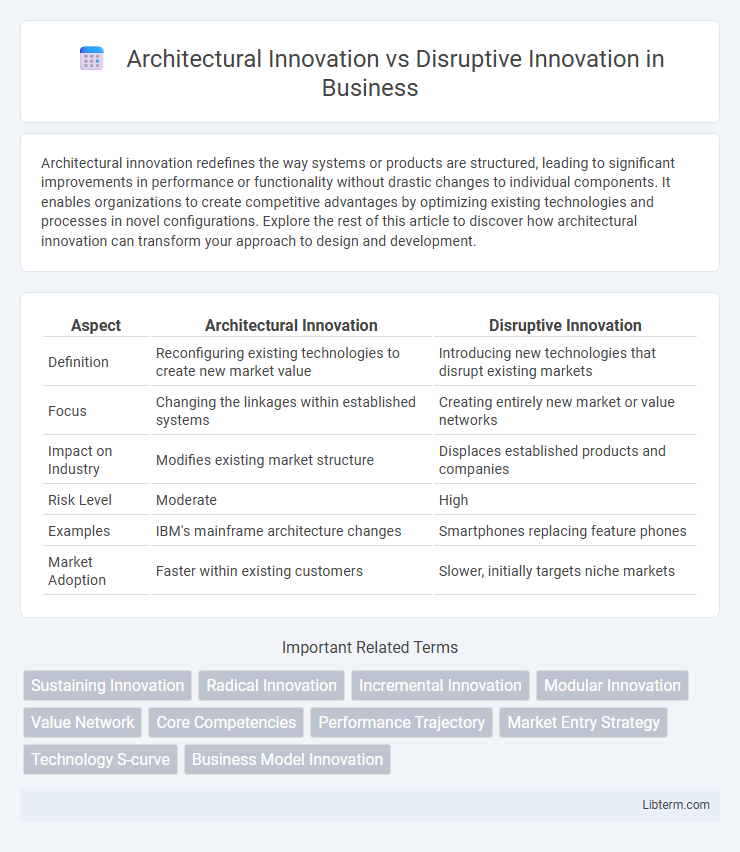Architectural innovation redefines the way systems or products are structured, leading to significant improvements in performance or functionality without drastic changes to individual components. It enables organizations to create competitive advantages by optimizing existing technologies and processes in novel configurations. Explore the rest of this article to discover how architectural innovation can transform your approach to design and development.
Table of Comparison
| Aspect | Architectural Innovation | Disruptive Innovation |
|---|---|---|
| Definition | Reconfiguring existing technologies to create new market value | Introducing new technologies that disrupt existing markets |
| Focus | Changing the linkages within established systems | Creating entirely new market or value networks |
| Impact on Industry | Modifies existing market structure | Displaces established products and companies |
| Risk Level | Moderate | High |
| Examples | IBM's mainframe architecture changes | Smartphones replacing feature phones |
| Market Adoption | Faster within existing customers | Slower, initially targets niche markets |
Defining Architectural Innovation
Architectural innovation involves reconfiguring existing technologies and components to create new market opportunities without altering the core design principles, contrasting with disruptive innovation which introduces entirely new technologies that reshape markets. This type of innovation leverages established knowledge and capabilities to modify the architecture of a product or system, enabling firms to enter adjacent markets or meet evolving customer needs. Understanding architectural innovation is crucial for businesses seeking to extend product life cycles and capitalize on existing assets while maintaining competitive advantage.
Defining Disruptive Innovation
Disruptive innovation refers to a process where a smaller company with fewer resources successfully challenges established incumbent businesses by targeting overlooked segments with simpler, more affordable products or services. This innovation often starts at the low end of the market or creates a new market entirely, eventually displacing dominant competitors. Unlike architectural innovation, which reconfigures existing technologies for established markets, disruptive innovation fundamentally changes market dynamics and consumer behaviors.
Key Differences Between Architectural and Disruptive Innovation
Architectural innovation reconfigures existing technologies to enter new markets, altering product architecture without changing core components, while disruptive innovation introduces new technologies that create entirely new markets or significantly transform existing ones. Architectural innovation leverages established skill sets and resources, emphasizing the rearrangement of known systems, whereas disruptive innovation challenges and eventually displaces incumbent technologies or business models. The key difference lies in scope and impact: architectural innovation modifies market boundaries through adaptation, while disruptive innovation replaces current paradigms with groundbreaking advances.
Historical Examples of Architectural Innovation
Architectural innovation involves reconfiguring existing technologies in novel ways to create new markets or improve performance, exemplified by the transition from mainframe computers to personal computers where existing components were repurposed efficiently. The Boeing 707 demonstrated architectural innovation by integrating jet engines with airframe designs from propeller aircraft, revolutionizing commercial aviation without reinventing core technologies. These historical cases highlight how architectural innovation reshapes industries by leveraging existing technology frameworks rather than developing entirely new technologies.
Historical Examples of Disruptive Innovation
Disruptive innovation reshaped markets by introducing groundbreaking technologies, as seen with the advent of the personal computer in the 1970s, which transformed computing from industrial-scale mainframes to accessible home devices. Another pivotal example is the rise of digital photography in the late 20th century, replacing film cameras and revolutionizing image capture and sharing. These innovations created new industries, disrupted established players, and redefined consumer behavior.
Impact on Existing Markets and Industries
Architectural innovation reshapes the configuration of existing components within established markets, enabling firms to improve or diversify products without fundamentally altering industry standards. Disruptive innovation, by contrast, introduces simpler, more affordable solutions that initially target underserved segments, eventually redefining or displacing incumbent market leaders. The impact of architectural innovation primarily enhances current industry structures, while disruptive innovation transforms or creates entirely new market dynamics.
Challenges in Implementing Architectural Innovation
Implementing architectural innovation presents challenges such as reconfiguring existing systems and processes without altering core components, which demands significant organizational flexibility. Firms often struggle with internal resistance due to changes in knowledge networks and resource allocation, impacting collaboration and decision-making. Balancing incremental improvements while managing uncertainty in new integration methods requires strategic alignment and robust change management frameworks.
Barriers to Disruptive Innovation Adoption
Disruptive innovation faces significant barriers including organizational inertia, limited resource allocation, and existing market dominance favoring incumbent technologies. Firms often resist adopting disruptive technologies due to uncertainty, risk aversion, and misalignment with current business models. Structural barriers, such as entrenched customer expectations and regulatory constraints, further hinder the widespread adoption of disruptive innovations compared to architectural innovation, which typically involves reconfiguring existing technologies within familiar markets.
Evaluating Long-term Business Value
Architectural innovation reshapes existing technologies within established markets, enhancing long-term business value by improving efficiency and leveraging core competencies without drastic market shifts. Disruptive innovation, however, creates new markets or transforms existing ones by introducing simpler, more affordable products that can initially underperform but progressively capture significant market share. Evaluating long-term business value requires assessing architectural innovation's incremental gains against disruptive innovation's potential for high growth and market dominance despite greater initial uncertainty.
Choosing the Right Innovation Strategy
Choosing the right innovation strategy requires understanding the differences between architectural and disruptive innovation, where architectural innovation modifies existing systems to enhance performance within current markets, while disruptive innovation creates new markets by introducing groundbreaking technologies that initially underperform established products. Companies must evaluate their market position, resources, and long-term goals to determine whether incremental improvements or radical changes better support their strategic objectives. Aligning innovation strategy with organizational capabilities and customer needs maximizes competitive advantage and long-term growth potential.
Architectural Innovation Infographic

 libterm.com
libterm.com